
Hess Corporation is an American global independent energy company involved in the exploration and production of crude oil and natural gas. It was formed by the merger of Hess Oil and Chemical and Amerada Petroleum in 1968. Leon Hess was CEO from the early 1960s through 1995, after which his son John B Hess succeeded him as chairman and CEO. The company has agreed to be acquired by rival oil company Chevron.
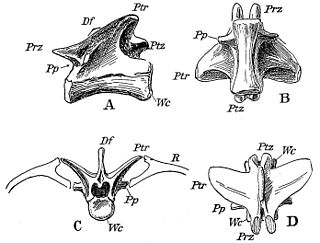
Pterospondylus is a dubious genus of theropod dinosaur from the Late Triassic. It was a coelophysid theropod which lived in what is now Germany. The type species, Pterospondylus trielbae,, was described by Jaekel in 1913–14 for a single back vertebra found inside the shell of the Proganochelys turtle. Sometimes, it is aligned with Procompsognathus, or even considered to be synonymous with it, despite being based on a vertebra that is twice the size of the corresponding bone in Procompsognathus. P. trielbae has no diagnostic features and is therefore considered a nomen dubium.

Palaeoniscum is an extinct genus of ray-finned fish from the Permian period (Guadalupian-Lopingian) of England, Germany, Turkey, North America and Greenland, and possibly other regions. The genus was named Palaeoniscum in 1818 by Henri Marie Ducrotay de Blainville, but was later misspelled as Palaeoniscus by Blainville and other authors. Palaeoniscum belongs to the family Palaeoniscidae.
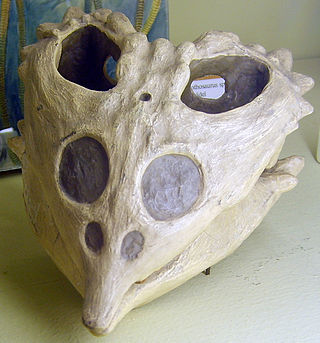
Placochelys is an extinct genus of placodont reptiles erected by Otto Jaekel in 1902.
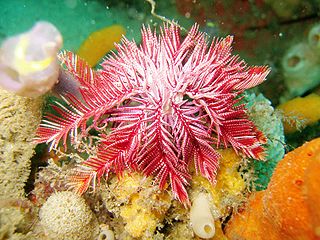
Articulata are a subclass or superorder within the class Crinoidea, including all living crinoid species. They are commonly known as sea lilies or feather stars. The Articulata are differentiated from the extinct subclasses by their lack of an anal plate in the adult stage and the presence of an entoneural system. Articulata first appeared in the fossil record during the Triassic period although other, now extinct crinoid groups, originated in the Ordovician.

Otto Max Johannes Jaekel was a German paleontologist and geologist.
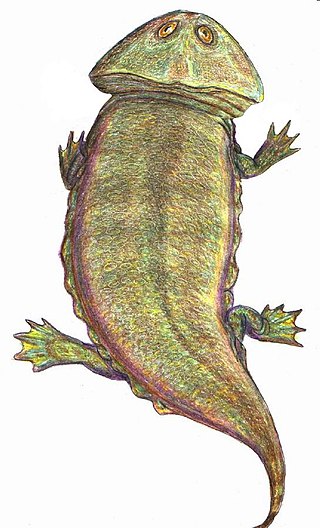
Plagiosaurus is an extinct genus of temnospondyl amphibian. The type and only species is P. depressus, first described by Otto Jaekel in 1914. Arthur Smith Woodward regarded the genus as a synonym of Plagiosternum, but most researchers consider it to be valid. It was paedomorphic, retaining the larval gills in adulthood. Like many stereospondyls, it had weak simplified vertebrae, consisting of large intercentra and neural arches, which is known as the stereospondylous condition.

Scincosaurus is an extinct genus of nectridean tetrapodomorphs within the family Scincosauridae.
Thomas Hess was a professional baseball catcher who played one season in Major League Baseball. He made his major league debut on June 6, 1892, and it would prove to be his last appearance as well. He would go on to play for multiple minor league teams.
Goya Jaekel is a former professional German football player.

Rudolf Walter Richard Hess was a German politician and a leading member of the Nazi Party in Nazi Germany. Appointed Deputy Führer to Adolf Hitler in 1933, Hess held that position until 1941, when he flew solo to Scotland in an attempt to negotiate the United Kingdom's exit from the Second World War. He was taken prisoner and eventually convicted of crimes against peace. He was still serving his life sentence at the time of his suicide in 1987.
Mesorhinosuchus is an extinct genus of basal phytosaur possibly known from the Early Triassic of Saxony-Anhalt, central-eastern Germany. It was first named by Otto Jaekel in 1910 and the type species is Mesorhinus fraasi. The generic name Mesorhinus was preoccupied by Mesorhinus piramydatus, a macraucheniid mammal, which is now considered to be a junior synonym of Oxyodontherium. Thus, an alternative generic name, Mesorhinosuchus, was proposed by Oskar Kuhn in 1961. The genus is occasionally misspelled as Mesorhinosaurus, while Stocker and Butler's study in 2013 misspelled its original generic name as Mesosuchus.

Walter Wood Hess Jr. was a United States Army brigadier general. He is most famous for his leadership as the commander of the artillery of the 36th Infantry Division.
Cyrtura is a dubious genus of extinct Testudinata from the Late Jurassic of the Solnhofen Formation of Bavaria, Germany. Cyrtura was originally described as a temnospondyl amphibian by Otto Jaekel in 1904 on the basis of MNB 1890, the distal portion of a tail with 14 caudal vertebrae. Most authors overlooked the genus, although those who mentioned Cyrtura dismissed it as either undiagnostic or referable to Testudines rather than Temnospondyli. Warren and Hutchinson (1983) rejected the temnospondyl classification of the genus based on examination of a cast of the holotype, and subsequent studies showed that Cyrtura is actually a marine turtle, although the lack of diagnostic characters renders it a nomen dubium.

Placidozoa is a recently defined non-photosynthetic lineage of Stramenopiles.
Thomas Jaekel is a German lightweight rower. He won a gold medal at the 1985 World Rowing Championships in Hazewinkel with the lightweight men's four.

Polysphenodon is an extinct genus of sphenodontian reptile with a single species Polysphenodon mulleri from the Late Triassic Keuper Group of Germany.

The Jaekel House is a 2-storey colonial mansion in Ebute Metta, Lagos, Nigeria. The house was built in 1898 on a large expanse of landscaped land and named after the late Francis Jaekel OBE, a former superintendent of the Nigerian Railway Corporation who retired in the 1970s after almost three decades of active service. Jaekel House was formally the residence of the General Manager and was later converted to a senior staff rest house. The building has been renovated and restored by Professor John Godwin in collaboration with the Railway Corporation in 2010. The building is now a “mini Museum” showcasing photographic archives dating from 1940s through to 1970s of personalities, places, historical events in pre- and post-independent Nigeria and houses artefacts of the old Railway Corporation. It's also one of the fairy tale wedding locations in Lagos.
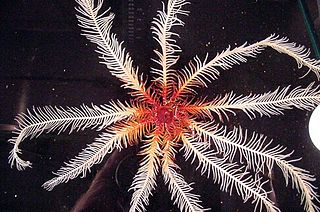
Pentacrinoidea is a subclass of crinoids containing all members of Crinoidea except for the exclusively Paleozoic camerates. It was originally named in 1918 by Otto Jaekel, who hypothesized a fundamental split between camerate and non-camerate crinoids. Later workers doubted this interpretation, and Pentacrinoidea was rarely used during the rest of the 20th century. Recent phylogenetic work has provided strong support for Jaekel's hypothesis, and Pentacrinoidea was reinstated in a 2017 revision of crinoid systematics.
Adianthidae is an extinct family of litopterns that existed from the Middle Eocene (Mustersan) to the Early Miocene (Santacrucian).














